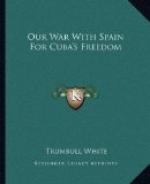Cock fighting is the national sport, and men, women and children will wager their last possession on the result of an encounter between chickens of fighting blood. The goose fight is another cruel sport. Two poles are placed in the ground, with a rope stretched between them, on which a live goose is hung with its feet securely tied, and its head thoroughly greased. The contestants are on horseback, and ride at full speed past the goose, endeavoring to seize its head and separate it from the body as they pass. The fowl usually dies before the efforts are successful, but the rider who finally succeeds in the noble endeavor gains the glory and the prize.
There is a patron saint for every village, for whom there is a feast day, which is celebrated by masses at the church, and afterwards by games and dances. A procession is always arranged on this day, in which a little girl, dressed as an image, rides in a wagon, decorated with banners and flowers. Men in costumes of Indians lead the way, followed by others clad as Moors. A band is a necessary adjunct, and bringing up the rear are the inhabitants, marching and singing to the music of the band. When the church is reached, the people gather about the child, and she recites a composition written for the occasion.
During carnival time, processions of mountebanks, cavaliers, dressed as knights of old, on horses splendidly adorned, races, masques, balls and all manner of revelries are indulged in.
Dancing is a universal accomplishment, in which the young and old find enjoyment in all places and at all seasons. The Zapato, a dance peculiar to Cuba, is performed to the music of the guitar, accompanied by the voices of the dancers. It consists of fantastic posings, fancy marches, and graceful figures, and resembles in some details the “cake walks” of the negroes of our own country.
An island farm.
In the neighborhood of the larger cities are hundreds of “Estancias,” which correspond to what are known as market gardens in the United States. These farms usually consist of less than a hundred acres each, and on them are raised vegetables, chickens, small fruits and other table delicacies, for the city trade. Properly looked after, this business might be one of great profit, but the land is, as a rule, cultivated by tenants, who pay a rental of about five dollars per acre a year, and who are too indolent to give it the care necessary to gain lucrative returns.
The principal vegetable raised on these farms is the sweet potato, of which there are two varieties, the yellow and the white. The soil and the climate are not favorable to the cultivation of the Irish potato, and it is necessary to import this luxury, which accounts for the fact that they are seldom seen outside the cities.
Plantains are raised in large quantities. This product is to the Cuban what bread is to us, and may be characterized as the standard article of food. Though less nutritious than wheat or potatoes, it is produced in vastly larger quantities from the same area, and with far less effort. It closely resembles the banana, and is in fact often regarded as a variety of that fruit. A fanciful name for it among the natives is “Adam’s apple,” and the story is that it was the forbidden fruit of the Garden of Eden.




